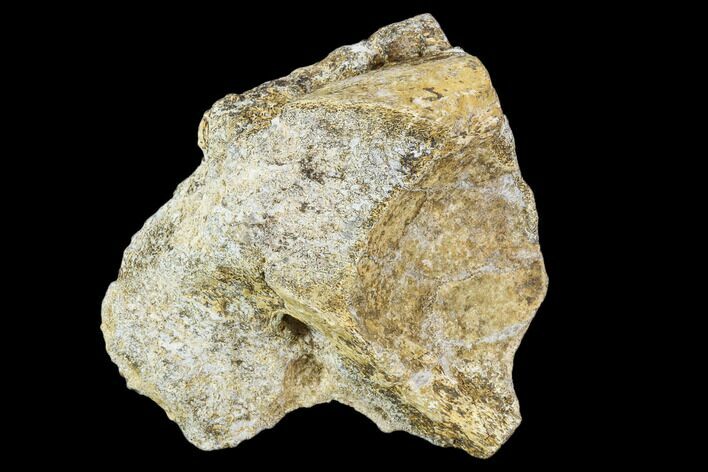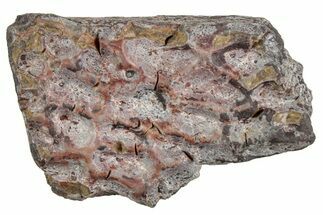This Specimen has been sold.
2.7" Fossil Synapsid (Dimetrodon or Edaphosaurus) Bone - Texas
This is a 2.7" fossil Synapsid pelvis bone from the Moran Formation, Texas. There are no diagnostic indicators so assigning a species to this bone would be problematic. This specimen is the socket where the femur ball sits.
The most prominent feature of Dimetrodon is the large sail on its back, formed by elongated spines extending from the vertebrae. It walked on four legs and had a tall, curved skull with large teeth of different sizes set along the jaws. Most fossils have been found in the southwestern United States, the majority from a geological deposit called the Red Beds in Texas and Oklahoma.
Dimetrodon is often mistaken for a dinosaur or a contemporary of dinosaurs in popular culture, but it became extinct some 40 million years before the first appearance of dinosaurs. Reptile-like in appearance and physiology, Dimetrodon is nevertheless more closely related to mammals than to modern reptiles, though it is not a direct ancestor or descendant of mammals.
Dimetrodon is assigned to a group traditionally called "mammal-like reptiles", more recently termed "stem-mammals" or "non-mammalian synapsids". That is, many vertebrate paleontologists today group Dimetrodon together with mammals in an evolutionary group, or clade, called Synapsida, while they place dinosaurs with living reptiles and birds in a separate clade, Sauropsida. Single openings in the skull behind each eye, known as temporal fenestrae, and other skull features distinguish Dimetrodon and mammals from most of the earliest sauropsids.
Dimetrodon was probably one of the top predators in Early Permian ecosystems, feeding on fish and tetrapods, including reptiles as well as amphibians. Smaller Dimetrodon species may have had different ecological roles. Dimetrodon's sail may have been used to stabilize its spine or to heat and cool its body as a form of thermoregulation. Some recent studies argue that the sail would have been ineffective at removing heat from the body, and was most likely used in sexual display.
Edaphosaurus is an important fossil: it is one of the earliest known large plant-eating (herbivorous) amniote tetrapods (four-legged land-living vertebrates). In addition to the large tooth plates in its jaws, the most characteristic feature of Edaphosaurus is a sail on its back. A number of other synapsids from the same time period also have tall dorsal sails, most famously the large apex predator Dimetrodon. However, the sail on Edaphosaurus is different in shape and morphology: Dimetrodon's is straighter and comes to more of a point at the center, while
The most prominent feature of Dimetrodon is the large sail on its back, formed by elongated spines extending from the vertebrae. It walked on four legs and had a tall, curved skull with large teeth of different sizes set along the jaws. Most fossils have been found in the southwestern United States, the majority from a geological deposit called the Red Beds in Texas and Oklahoma.
Dimetrodon is often mistaken for a dinosaur or a contemporary of dinosaurs in popular culture, but it became extinct some 40 million years before the first appearance of dinosaurs. Reptile-like in appearance and physiology, Dimetrodon is nevertheless more closely related to mammals than to modern reptiles, though it is not a direct ancestor or descendant of mammals.
Dimetrodon is assigned to a group traditionally called "mammal-like reptiles", more recently termed "stem-mammals" or "non-mammalian synapsids". That is, many vertebrate paleontologists today group Dimetrodon together with mammals in an evolutionary group, or clade, called Synapsida, while they place dinosaurs with living reptiles and birds in a separate clade, Sauropsida. Single openings in the skull behind each eye, known as temporal fenestrae, and other skull features distinguish Dimetrodon and mammals from most of the earliest sauropsids.
Dimetrodon was probably one of the top predators in Early Permian ecosystems, feeding on fish and tetrapods, including reptiles as well as amphibians. Smaller Dimetrodon species may have had different ecological roles. Dimetrodon's sail may have been used to stabilize its spine or to heat and cool its body as a form of thermoregulation. Some recent studies argue that the sail would have been ineffective at removing heat from the body, and was most likely used in sexual display.
SPECIES
Dimetrodon or Edaphosaurus
LOCATION
Texas
FORMATION
Moran Formation
SIZE
2.7 x 2.5"
CATEGORY
SUB CATEGORY
ITEM
#107003
We guarantee the authenticity of all of our specimens.
 Reviews
Reviews














